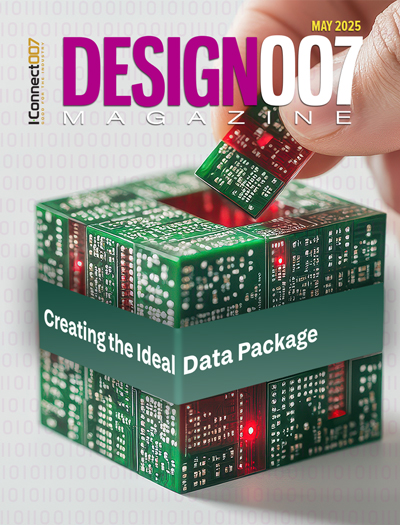-

- News
- Books
Featured Books
- design007 Magazine
Latest Issues
Current Issue
Creating the Ideal Data Package
Why is it so difficult to create the ideal data package? Many of these simple errors can be alleviated by paying attention to detail—and knowing what issues to look out for. So, this month, our experts weigh in on the best practices for creating the ideal design data package for your design.

Designing Through the Noise
Our experts discuss the constantly evolving world of RF design, including the many tradeoffs, material considerations, and design tips and techniques that designers and design engineers need to know to succeed in this high-frequency realm.

Learning to Speak ‘Fab’
Our expert contributors clear up many of the miscommunication problems between PCB designers and their fab and assembly stakeholders. As you will see, a little extra planning early in the design cycle can go a long way toward maintaining open lines of communication with the fab and assembly folks.
- Articles
- Columns
Search Console
- Links
- Media kit
||| MENU - design007 Magazine
Shrinking Silicon, EMI, and SI
March 3, 2023 | Andy Shaughnessy, Design007 MagazineEstimated reading time: 2 minutes
As IC features continue to shrink, the PCB designer’s job gets more interesting—signal speeds and rise times are increasing, they’re encountering EMI and signal integrity issues once only seen in the RF world.
Dr. Todd Hubing is a longtime EMC instructor, president of LearnEMC, and a professor emeritus of the Electrical and Computer Engineering program at Clemson University. I asked Todd to discuss the challenges that shrinking silicon can present for traditional PCB designers, as well as the opportunities and benefits of smaller chip features.
Andy Shaughnessy: Shrinking silicon is causing an increase in EMI and SI issues for PCB designers and EEs. What sort of problems does shrinking silicon cause?
Todd Hubing: When the features of an IC shrink, transition times tend to be faster, and the high-frequency content of digital signals tends to increase. When newer, faster ICs are used in products that were designed with the older versions of those ICs, those products can suddenly start failing to meet EMC or SI requirements even though there was no nominal change in the design. ICs with smaller features can also be more susceptible to damage by voltage transients, though that largely depends on the mitigation features built into the design.
Shaughnessy: What is the relationship between smaller silicon and EM fields, and what can these designers do to proactively fight EMI and SI?
Hubing: Field coupling directly from an IC is not directly affected by smaller silicon. Field coupling depends more on the currents pulled through the inductance of the lead-frame. Shrinking the features on the silicon can cause those currents to be higher or lower at any given frequency depending on the application.
To protect against future silicon feature-size changes, PCB designers should always proactively control the transition times of any signal that could ultimately be the source of crosstalk or radiated emissions. They shouldn’t rely on “slow” devices to meet EMI and SI requirements.
Shaughnessy: If we add increased rise time and faster signals into this mix, how does material and material selection figure into the equation? Do you think OEMs should select their material, or allow the fab to do so?
Hubing: I believe laminate selection is strictly an SI issue, and then only for the fastest digital signals. Choosing whether to let the fabricator select the laminate depends on the many factors, but, in my opinion, that decision is unlikely to be impacted by silicon shrinkage.
To read this entire interview, which appeared in the February 2023 issue of Design007 Magazine, click here.
Suggested Items
DuPont Announces Additional Leaders and Company Name for the Intended Spin-Off of the Electronics Business
04/29/2025 | PRNewswireDuPont announced Qnity Electronics, Inc. as the name of the planned independent Electronics public company that will be created through the intended spin-off of its Electronics business.
Real Time with... IPC APEX EXPO 2025: Benmayor Group—Resistance is Futile: Automation Is the Future
04/11/2025 | Real Time with...IPC APEX EXPOJeff Brandman, president of Aismalibar North America, and Eduardo Benmayor, CEO of Benmayor Group, discuss Benmayor Group's role in electronics and automation, focusing on how automation addresses labor shortages. Jeff, notes that many businesses struggle to find workers for manual tasks, emphasizing the need for various automation solutions to boost productivity. North America lags in automation compared to other regions, which impacts efficiency. Jeff recommends a step-by-step approach to scaling automation, and there's growing acceptance of robots in the workforce, leading to a positive outlook for the future.
Real Time with... IPC APEX EXPO 2025: Exploring Ventec's Innovations
04/09/2025 | Real Time with...IPC APEX EXPOMark Goodwin highlights Ventec's global distribution network and recent expansions in service and equipment offerings. He emphasizes the company's expertise in coating technology for thermal management, specialized materials, and its agility in creating customized solutions for customers.
INEMI Sessions at IPC APEX EXPO Focus is on Board Assembly and PCB & Laminates
03/12/2025 | iNEMIIf you plan to attend the upcoming IPC APEX EXPO in Anaheim, California, be sure to add the INEMI sessions to your calendar. We will have two forward-looking sessions — one on PCB and Laminates and the other on Board Assembly.
Rogers Corporation Launches New Thermoset Laminates for Automotive Radar Sensor Applications
03/03/2025 | Rogers CorporationRogers Corporation (NYSE:ROG) announced its latest innovation in dielectric materials: RO4830™ Plus Circuit Materials, which are well suited for cost-sensitive millimeter wave PCB applications, such as 76-81 GHz automotive corner radar sensors.


